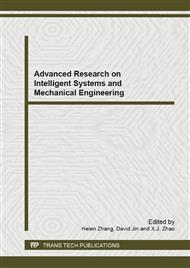p.56
p.60
p.64
p.68
p.72
p.77
p.81
p.85
p.89
Intelligent Control of Valve-Controlled Electro-Hydraulic System in Erecting Device Based on Mechanical Mechanics
Abstract:
According to the fast and stable requirements of erecting device, the characteristic of dynamics was analyzed and several common law of motion curve was discussed. The erecting curve was optimized and different stress and impact problems of Multi-stage Cylinder were studied to establish the system model. Fuzzy PID control algorithm was used to co-simulate in erecting process to optimize the control parameters, which can weaken impact when the working parts was in place in erecting process. The experiment shows that the erecting time is about 50s and collision is decreased when the Multi-stage Cylinder is stickled out in grade change to reduce hydraulic impact. So it may be have an important guidance and application value in engineering.
Info:
Periodical:
Pages:
72-76
Citation:
Online since:
January 2013
Authors:
Price:
Сopyright:
© 2013 Trans Tech Publications Ltd. All Rights Reserved
Share:
Citation:


